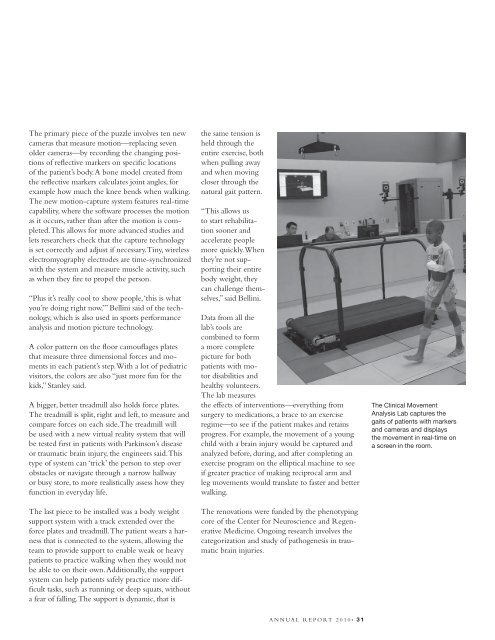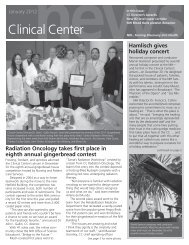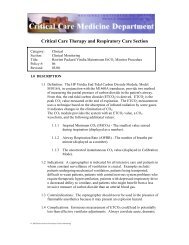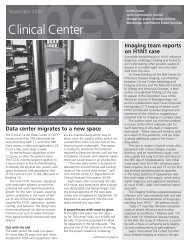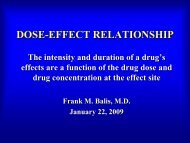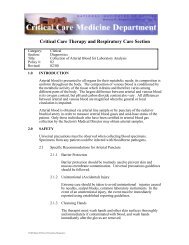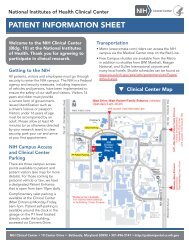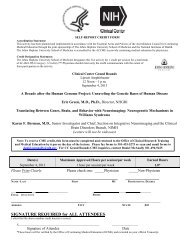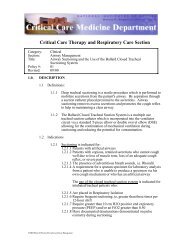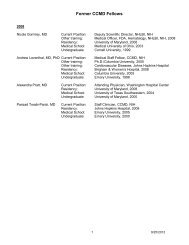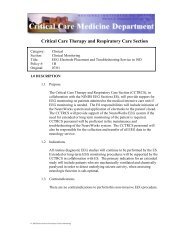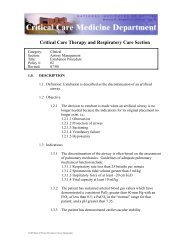2011 - NIH Clinical Center - National Institutes of Health
2011 - NIH Clinical Center - National Institutes of Health
2011 - NIH Clinical Center - National Institutes of Health
Create successful ePaper yourself
Turn your PDF publications into a flip-book with our unique Google optimized e-Paper software.
The primary piece <strong>of</strong> the puzzle involves ten newcameras that measure motion—replacing sevenolder cameras—by recording the changing positions<strong>of</strong> reflective markers on specific locations<strong>of</strong> the patient’s body.A bone model created fromthe reflective markers calculates joint angles, forexample how much the knee bends when walking.The new motion-capture system features real-timecapability, where the s<strong>of</strong>tware processes the motionas it occurs, rather than after the motion is completed.Thisallows for more advanced studies andlets researchers check that the capture technologyis set correctly and adjust if necessary.Tiny, wirelesselectromyography electrodes are time-synchronizedwith the system and measure muscle activity, suchas when they fire to propel the person.“Plus it’s really cool to show people,‘this is whatyou’re doing right now,’” Bellini said <strong>of</strong> the technology,which is also used in sports performanceanalysis and motion picture technology.A color pattern on the floor camouflages platesthat measure three dimensional forces and momentsin each patient’s step.With a lot <strong>of</strong> pediatricvisitors, the colors are also “just more fun for thekids,” Stanley said.A bigger, better treadmill also holds force plates.The treadmill is split, right and left, to measure andcompare forces on each side.The treadmill willbe used with a new virtual reality system that willbe tested first in patients with Parkinson’s diseaseor traumatic brain injury, the engineers said.Thistype <strong>of</strong> system can ‘trick’ the person to step overobstacles or navigate through a narrow hallwayor busy store, to more realistically assess how theyfunction in everyday life.The last piece to be installed was a body weightsupport system with a track extended over theforce plates and treadmill.The patient wears a harnessthat is connected to the system, allowing theteam to provide support to enable weak or heavypatients to practice walking when they would notbe able to on their own.Additionally, the supportsystem can help patients safely practice more difficulttasks, such as running or deep squats, withouta fear <strong>of</strong> falling.The support is dynamic, that isthe same tension isheld through theentire exercise, bothwhen pulling awayand when movingcloser through thenatural gait pattern.“This allows usto start rehabilitationsooner andaccelerate peoplemore quickly.Whenthey’re not supportingtheir entirebody weight, theycan challenge themselves,”said Bellini.Data from all thelab’s tools arecombined to forma more completepicture for bothpatients with motordisabilities andhealthy volunteers.The lab measuresthe effects <strong>of</strong> interventions—everything fromsurgery to medications, a brace to an exerciseregime—to see if the patient makes and retainsprogress. For example, the movement <strong>of</strong> a youngchild with a brain injury would be captured andanalyzed before, during, and after completing anexercise program on the elliptical machine to seeif greater practice <strong>of</strong> making reciprocal arm andleg movements would translate to faster and betterwalking.The renovations were funded by the phenotypingcore <strong>of</strong> the <strong>Center</strong> for Neuroscience and RegenerativeMedicine. Ongoing research involves thecategorization and study <strong>of</strong> pathogenesis in traumaticbrain injuries.The <strong>Clinical</strong> MovementAnalysis Lab captures thegaits <strong>of</strong> patients with markersand cameras and displaysthe movement in real-time ona screen in the room.A N N U A L R E P O RT 2 0 1 0 • 3 1


